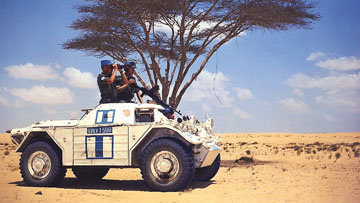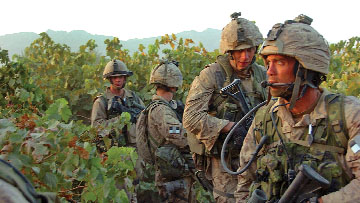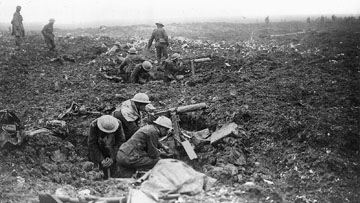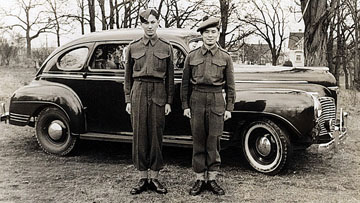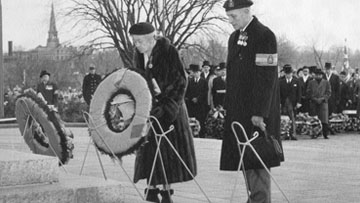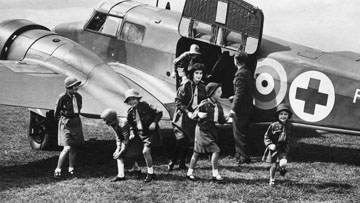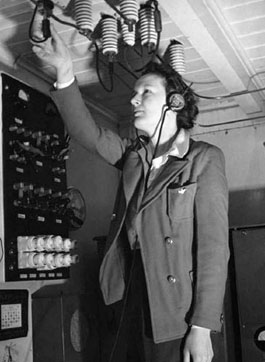Canada Remembers Times - 2016 Edition - Page 2
Six decades of fostering peace
Canadian peacekeepers patrolling the Egypt-Israel border.
(Photo: Department of National Defence ZK-1946-17)
2016 marks the 60th anniversary of large-scale United Nations (UN) peace support efforts. Our country has been involved in these special missions from the start, dating back to the Suez Crisis of 1956. This tense Middle East standoff between Egypt on one side and Israel, Britain and France on the other threatened to draw the international community into war.
Lester B. Pearson, Canada’s minister of External Affairs and future prime minister, successfully proposed that a multinational force drawn from UN countries (including Canada) would go to Egypt to enforce a cease-fire and oversee the pull out of foreign forces. This idea of sending neutral forces to nurture peace in regions in turmoil earned Pearson the 1957 Nobel Peace Prize. It would have a lasting impact on the way the world responded to conflicts and helped define Canada’s international military role in the decades that followed.
In the heat of battle in Afghanistan
Canadian Armed Forces members during Operation Medusa.
(Photo: Department of National Defence AR2006-P005-0011)
More than 40,000 Canadian Armed Forces members served in a variety of roles on the ground, in the air and at sea in the Afghanistan theatre of operations from 2001 to 2014. The challenges and dangers these brave men and women faced were great and they were frequently targeted by roadside bombs and suicide attacks. They also took part in major combat with the Taliban forces who were trying to destabilize the country.
Operation Medusa was a Canadian-led offensive in Kandahar Province that was launched in September 2006. The goal was to clear insurgents from the Panjwai district. The many hostile villages, irrigation ditches, trenches, tunnels, extreme climate and improvised explosive devices made it a difficult place to fight. More than 1,000 Canadians, along with over 400 soldiers from other countries, took part. It was Canada’s largest combat operation in more than 50 years and our soldiers took heavy fire, but the Taliban was pushed from the district. The cost was high, however, and 12 Canadians were killed in the two-week offensive.
Sadly, a total of 158 Canadian Armed Forces members lost their lives in Afghanistan. Those who served have been remembered in many ways, from the "Highway of Heroes" commemorative roads to the dates of the Afghanistan mission being inscribed on the National War Memorial.
A country’s coming of age
Canadian machine gunners digging in on Vimy Ridge.
(Photo: Library and Archives Canada PA-001017)
April 9, 2017, is going to be a special milestone for our country as it will mark the 100th anniversary of the Battle of Vimy Ridge. This major First World War battle along the Western Front in France saw 100,000 Canadians come together to achieve the biggest Allied offensive success up to that point of the conflict. A high price was paid, however, as some 3,600 Canadians lost their lives during the four days of fighting at Vimy and over 7,000 more were wounded. Some have said that the experience of soldiers from coast to coast fighting together to achieve such a great triumph at Vimy Ridge helped us forge a stronger national identity—that it was indeed Canada’s ‘coming of age’ as a country of our own.
Thousands of students will take part in commemorative events in Canada and France next spring to mark this centennial anniversary. How will you be remembering Vimy Ridge?
A life of service
Douglas Jung (left) with John Ko Bong.
(Photo: Chinese Canadian Military Museum Society)
Douglas Jung was born in British Columbia in 1924. He joined the Canadian Army during the Second World War and trained for secret operations in Asia. Jung became a lawyer and ran in the 1957 federal election. He was elected in the Vancouver Centre riding, becoming the first Chinese-Canadian Member of Parliament. Jung later represented our country at the United Nations. Throughout his life, he lobbied for the rights of Asian-Canadians and Veterans. He received the Order of Canada in 1990.
All in the family
National Memorial Cross mother Julienne Cantin laying a wreath.
(Photo: Courtesy of Albert Cantin)
Many Canadian families sacrificed greatly during the war years but few can match the contributions of the Cantins from the farming community of McCreary, Manitoba.
Albert, Amedee, Clement, Joseph, Lionel, Marie, Maurice, Noel, Wilfred, sons and daughter of Julienne and Amedee Cantin, all served in the Canadian military during the Second World War. Clement Nivon, a nephew who was raised by the family, also enlisted. Daughter-in-law Evelyn would serve too.
In total, 11 members of the family volunteered. Five of the boys joined the Royal Canadian Air Force, the other four chose the Fort Garry Horse armoured regiment. Marie became a Nursing Sister and Evelyn joined the Canadian Women’s Army Corps. Sadly, Wilfred, Maurice and Clement lost their lives.
In recognition of the family’s great service and sacrifice, Julienne Cantin was named the 1960 National Memorial Cross Mother.
Tough cookies, smart cookies
Girl Guides contributed to buying two air ambulances during the Second World War.
(Photo: Girl Guides of Canada Archives)
Similar to our military members, the Girl Guides of Canada wear uniforms with badges. Appropriately, they have had many interesting connections to our country’s war efforts over the years.
During the First World War, the newly formed group helped in various ways, like knitting socks for soldiers. In the Second World War, the girls once again whole-heartedly volunteered many hours, and even fundraised enough to help purchase two air ambulances for the Allies.
In the 1950s, Girl Guide units were formed at Canadian military bases in Europe to help the daughters of service families feel connected to home. More recently, during the 1990-1991 Gulf War, our Girl Guides managed to send their famous cookies to Canadian Armed Forces members serving in the Middle East. What a sweet treat!
This determination hasn’t faded as new generations of girls keep up this tradition of support. Many participate with great pride in the "Valentines for Vets" program, sending hand-made thank you cards to Veterans living in long-term care facilities across the country.
Waves of change
Fern Blodgett with ship’s radio equipment.
(Photo: Public domain)
Fern Blodgett was born in Regina, Saskatchewan and raised in Cobourg, Ontario. She was 21 years old when the Second World War began. She had long hoped to sail and the war would help her achieve her dream.
Blodgett attended night classes to become a ship’s radio operator but it was hard for a woman to get a job at sea. In June 1941, however, she heard that the Norwegian merchant ship Mosdale was desperately seeking a reliable radio operator. Blodgett knew she could do the job and travelled to Montréal to meet with the captain, convincing him that she was qualified for the position. She made a total of 78 voyages with the ship on the dangerous waters of the North Atlantic during the war. She also found love at sea, marrying Gerner Sunde, captain of the vessel. Blodgett was decorated with the Norwegian War Medal for her gallant service. She had become a beacon for other women in the Merchant Navy that would follow in her wake.
- Date modified:
